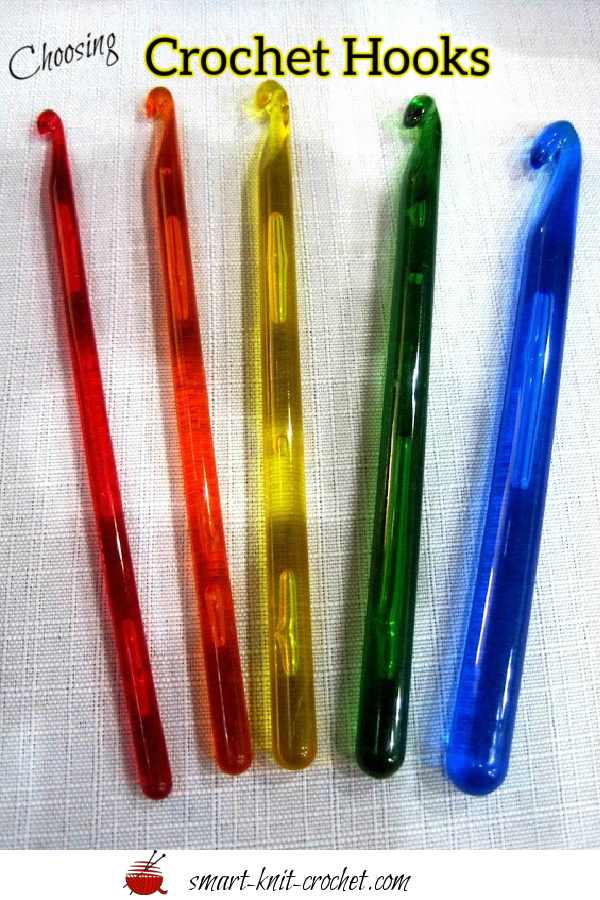- Home
- How to Crochet
- Crochet Hooks
Crochet Hooks: Chose the Right Tool for the Job
Crochet Hooks: by Janice Jones
If you go into any big-box craft shop, you may be overwhelmed by the variety of hooks available. Not only do they come in different colors and sizes, but they also differ in the materials they are made from. Another important difference in hooks is that not all tips or grips are made the same, and these characteristics often make a huge difference to your comfort and work.
First, let's look at the different materials used to make crochet hooks.
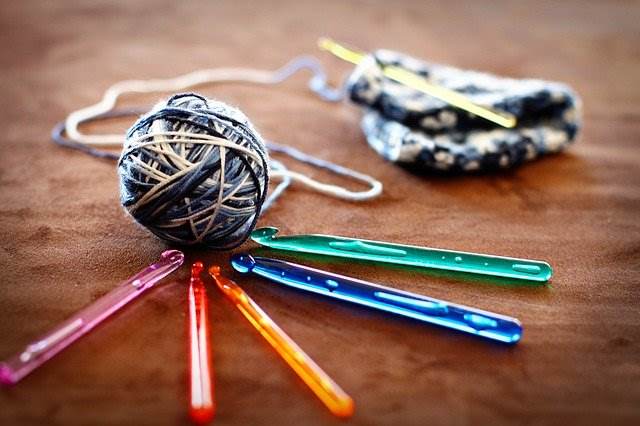
Materials Used to Make Crochet Hooks
Several materials are used to make crochet hooks:
- Aluminum
- Plastic
- Wooden
- Bamboo
- Steel
There are advantages and disadvantages of each type.
Aluminum Hooks
Advantages:
- Lightweight and easy to handle
- Smooth surface allows yarn to glide easily
- Durable and long-lasting
- Affordable and widely available
- Suitable for most yarn types and projects
- Many are made with a soft ergonomic handle that is easy on the hands
Disadvantages:
- May feel cold to the touch, which can be uncomfortable for some users
- Slippery surface may cause some yarns to split or slip off the hook
- Some users may find the hook too narrow or the handle too small for comfortable use
Plastic Hooks
Advantages:
- Lightweight and easy to handle
- Smooth surface allows yarn to glide easily
- Available in a wide range of colors and sizes, especially larger sizes
- Affordable and widely available
- Suitable for most yarn types and projects
Disadvantages:
- May not be as durable as other materials, especially with heavy use
- Some plastic hooks may have rough edges or seams that can snag yarn
- Cheaper plastic hooks may bend or break under pressure
Wooden Hooks:
Advantages:
- Warm and comfortable to hold, especially for extended periods
- Smooth surface allows yarn to glide easily
- Lightweight yet sturdy
- Aesthetically pleasing and often handcrafted
- Suitable for most yarn types and projects
Disadvantages:
- May be more expensive than aluminum or plastic hooks
- Wood may wear down or splinter over time with heavy use
- Some wooden hooks may have inconsistent sizing or shape
Bamboo Hooks
Advantages:
- Eco-friendly and sustainable material
- Warm and comfortable to hold, especially for extended periods
- Smooth surface allows yarn to glide easily
- Lightweight yet sturdy
- Suitable for most yarn types and projects
Disadvantages:
- May be more expensive than aluminum or plastic hooks
- Some bamboo hooks may have inconsistent sizing or shape
- Bamboo may wear down or splinter over time with heavy use
Steel Hooks
Advantages:
- Extremely durable and long-lasting
- Smooth surface allows yarn to glide easily
- Ideal for fine, delicate yarns and intricate lace projects
- Available in very small sizes for detailed work
Disadvantages:
- Can be heavy and uncomfortable to hold for extended periods
- May be more expensive than other hook materials
- Not suitable for thicker yarns or larger projects
- Slippery surface may cause some yarns to split or slip off the hook
There is no right or wrong hook, but rather, it is the hook
that feels best for you. It is best to
experiment to see which one feels good and makes it easy to crochet without
hand strain.
How Much Can You Expect to Pay for a Crochet Hook
Prices can vary depending on the retailer, location, and any sales or promotions. Some brands also offer sets of hooks, which can be more cost-effective than purchasing individual hooks. When I find a hook that feels just right for me, I usually purchase an entire
Here is a breakdown of typical prices based on the what material is used for making the hook.
Aluminum Hooks
- Budget-friendly options: $1 to $3 per hook (e.g., Boye, Susan Bates)
- Mid-range options: $3 to $6 per hook (e.g., Clover, Knitter's Pride)
- Higher-end options: $6 to $10 per hook (e.g., Tulip Etimo, Addi Swing)
Plastic Hooks
- Budget-friendly options: $1 to $2 per hook (e.g., generic brands)
- Mid-range options: $2 to $4 per hook (e.g., Clover Amour, Knitter's Pride Waves)
- Higher-end options: $4 and above per hook (e.g., Clover Soft Touch, Furls Streamline). Larger hooks will be more expensive
Wooden Hooks
- Budget-friendly options: $3 to $6 per hook (e.g., Bamboo handled hooks)
- Mid-range options: $6 to $12 per hook (e.g., Brittany, Knitter's Pride Dreamz)
- Higher-end options: $12 to $30 per hook (e.g., Furls Alpha, Laurel Hill)
Bamboo Hooks
- Budget-friendly options: $2 to $4 per hook (e.g., generic brands)
- Mid-range options: $4 to $8 per hook (e.g., Clover Takumi, ChiaoGoo)
- Higher-end options: $8 to $15 per hook (e.g., Knitter's Pride Bamboo, Furls Odyssey)
Steel Hooks
- Budget-friendly options: $1 to $3 per hook (e.g., generic brands)
- Mid-range options: $3 to $6 per hook (e.g., Boye, Susan Bates)
- Higher-end options: $6 to $10 per hook (e.g., Tulip, Clover Amour Steel)
The Anatomy of Crochet Hooks
You probably don't need an anatomy lesson, but if the vocabulary pops up while you are in the middle of a project, here is a quick guide to identify the different parts of the hook.
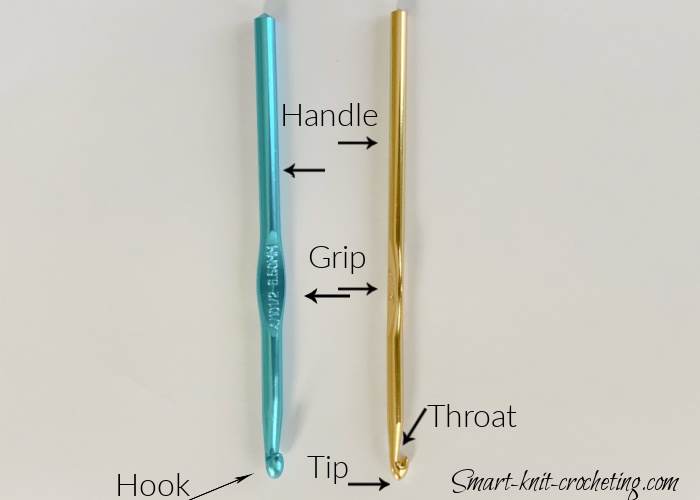 The parts of a hook
The parts of a hookCrochet Hook Parts and Why Should I care?
Handle
This is the part that rests in your hand. Is it comfortable? Be sure it is not too long, not too short, but just right. A very long hook can lead to fatigue and pain. The same is true of a too short handle. Let the Cinderella principle prevail when choosing a hook.
Handles can also be divided into the type of material used to make them. They can be standard without any additional materials used, or encased in wood, plastic, clay or rubber.
Grip
This is the part of the hook that you grab with your thumb and hand. Sometimes they are decorative and other times they are functional.
The grip becomes very important for people who are suffering from degenerative joint conditions or for those people who experience pain and hand fatigue when crocheting for long periods of time.
If this is you, consider a hook with a wider handle or one that is cushioned. Even for those who don't have any problems, using thinner grips may be the cause of your hand cramping.
Shaft
The shaft can be inline or tapered. The size of the hook is determined by measuring the width of the shaft. Sometimes the shaft can be shorter and feel less comfortable depending on how you hold the hook and also how you move the hook when you are making stitches.
Throat Types
The throat is located just under the hook and behind the head. Throat types can either be tapered or inline. Tapered throats are narrower than the shaft. Inline shafts are the same width as the shaft.
If the throat is too wide, it may create looser stitches. If the throat is too narrow, you may end up making tighter stitches. If you are having trouble creating the right gauge, this may be solved by using a hook that has a different throat type.
Head Type
Head types can either be pointed or rounded. If your head type is too pointed you may end up splitting the yarn, If it is too rounded, you may struggle to get into the stitches easily which will slow you down.
So you can see that all parts of a crochet hook can help or hurt you and the only way to know which is right for you is through experience. For this reason, I never recommend buying an entire set of hooks from one source. Decide which sizes you will use the most and then experiment with different manufacturers. Speaking of sizes...
Sizes of Crochet Hooks
The hook's size and the type of yarn you choose will determine the size of your stitches. Larger hooks are intended to be used with thicker yarns and will, therefore, make larger stitches. You should be able to identify the hook's size because they are stamped somewhere on the hook.
How Crochet Hooks are Labeled (US, Metric)
All U.S. hooks are labeled with a letter. Some also include a number. As you progress through the alphabet, the hooks get larger. Larger hooks are used with thicker bulkier yarns, and smaller needles use fine yarns.
Hooks are also sized by their diameter in millimeters. Most of the world uses the metric system so they look for the hooks they need in mm. Most hooks are labeled with both, so for example you would see the size written as US H/5.0 mm.
If you are taking up crocheting and depending on the internet for tips and tutorials, it's important to understand where the instructions are originating.
Sometimes you will see a hook size of 8 which is an old imperal term sometimes used in the UK. A size 8 UK, is also US G/6 or 4.00 mm.
Here is an online conversion chart, but if you would prefer to download and print one out for your records, you are welcome to do so. See below.
Crochet Hook Conversion Chart
EU: Metric
0.6 mm
0.75 mm
1 mm
1.25 mm
1.5 mm
1.75 mm
2 mm
2.25 mm
2.5 mm
2.75 mm
3 mm
3.25 mm
3.5 mm
3.75 mm
4 mm
4.5 mm
5 mm
5.5 mm
6 mm
6.5 mm
7 mm
8 mm
9 mm
10 mm
12 mm
15 mm
20 mm
USA Sizes
14 steel
12 steel
11 steel
7 steel
6 steel
5 steel
N/A
B/1
N/A
C/2
N/A
D/3
E/4
F/5
G/6
7
H/8
I/9
J/10
K/10 1/2
N/A
L/11
M/13
N/15
P
Q (16 mm)
S (10mm)
Old UK Sizes
N/A
N/A
N/A
N/A
N/A
N/A
14
N/A
12
N/A
10
N/A
9
N/A
8
7
6
5
4
3
2
N/A
N/A
N/A
N/A
N/A
N/A
Pin Crochet Hook Sizes for Future Reference
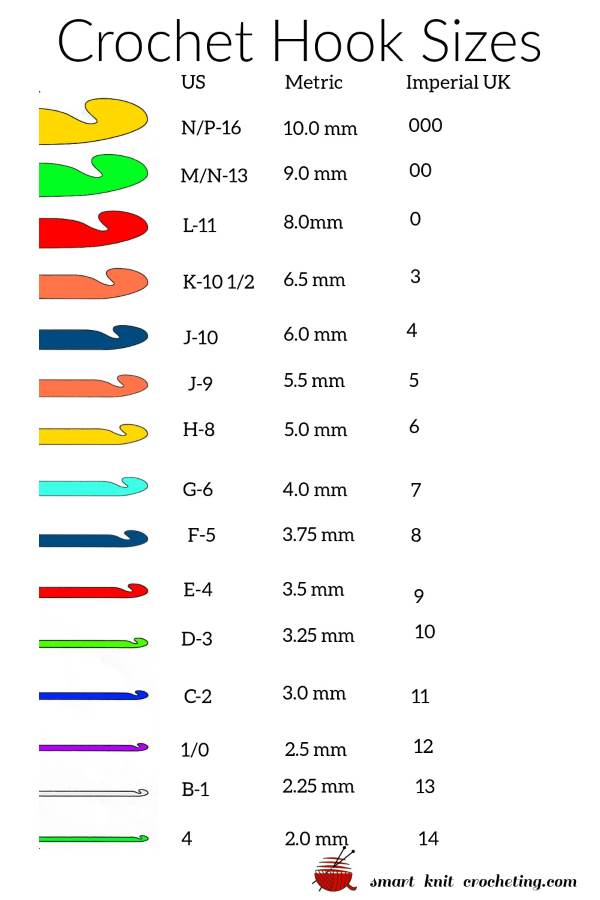
More About Types of Hooks
We've already discussed what materials are used to make them, but we haven't touched on the various type of hooks you might encounter. There are different types but I will discuss the most common types, single ended, Afghan or Tunisian and Double ended.
Single Ended Hook
These are the most common and the ones you will likely encounter in your craft shops. They are generally around 6 inches long and have a hook at one end.
As mentioned earlier, they are made in a wide range materials from steel to aluminum, bamboo, wood, plastic and even bone if you can get your hands on a vintage style hook.
Afghan Hook
This is a more advanced hook used to work Tunisian crochet. There is a hook at one end and a stopper at the end of the other side. They are longer, usually 10 inches in length, but can also be even longer.
These types of hooks are intended to hold multiple stitches. As with other types of crochet hooks, they are made of a variety of different materials ranging from plastic, resin, aluminum , bamboo and others.
You can purchase them individually or in sets. You can also purchase them as a stand-alone hook or as a set of interchangeable hooks that come in a variety of different sized cords or cable. Here are a few I found on Amazon.
Double Ended Hooks
These hooks have a hook at either end and is about 14 inches long. It often comes in a version with a flexible cable or as a stand-alone hook.
How to Choose the Correct Crochet Cook Based on the Yarn Weight and Project Type
We've discussed what hooks are made of and how they are sized. We've also talked about the different types of hooks, One ended, double ended and Afaghan/Tunsian. Now it is time to pair the right hook with the type of yarn you plan to use.
Choosing the right crochet hook size based on the yarn weight and project type is crucial for achieving the desired outcome and maintaining consistency in your work. The thickness or weight of the yarn is the primary factor that dictates the hook size.
Generally, each yarn label indicates the recommended hook size to ensure optimal results.
For example, lightweight or fine yarns, such as "sock" or "fingering," typically pair well with smaller hooks ranging from 2.25mm to 3.5mm.
Medium-weight yarns, such as "worsted" or "aran," are commonly used with hooks from 4.5mm to 5.5mm.
Bulky yarns require larger hooks from 6mm and above to create looser and more pronounced stitches.
The instructions or pattern will advise which size hook and thickness of yarn to use in most cases.
The design is a good starting point; however, it may be that you will need to make alterations to the pattern.
For example, if you create a garment that requires precise sizing, you will want to ensure that the final project, whether it is a sweater or coat, fits well. That is where gauge comes into play.
#0 Fingering Yarn
Gauge: 32 -42 dc/4 in/10 cm
Metric: 1.6 - 1.4mm Steel Hook
US: Steel 6, 7, 8, B1
#01: Fingering/Sock
Gauge: 21-32 dc/4 in/10 cm
Metric: 2.25-3.5 mm
US: B1-E4
#02 Sock/Baby
#02: Sock, Baby
Gauge: 16-20 dc /4 in/10 cm
Metric: 3.5-4.5mm
US: E4 - 7
#03: DK, Light Worsted
Gauge: 12-17 dc/4 in/10 cm
Metric: 4.5-5.5 mm
US 7 - I-9
#04: Worsted, Aran
Gauge: 11-14 dc/4 in/10 cm
Metric: 5.5 - 6.5 mm
US: I-9 - K 10 1/2
#05: Chunky
Gauge: 8-11 dc/4 in/10 cm
Metric: 6.5 - 9 mm
US: K 10 1/2 - M15
#06: Super Bulky
Gauge 7-9 dc/4 in/10 cm
Metric: 9-15 mm
US 13 - Q
#07: Jumbo
Gauge: 6 & Fewer
Metric: 15 & Larger
US: Q & Larger
Choose the Correct Crochet Hook for Your Project: A Word About Gauge
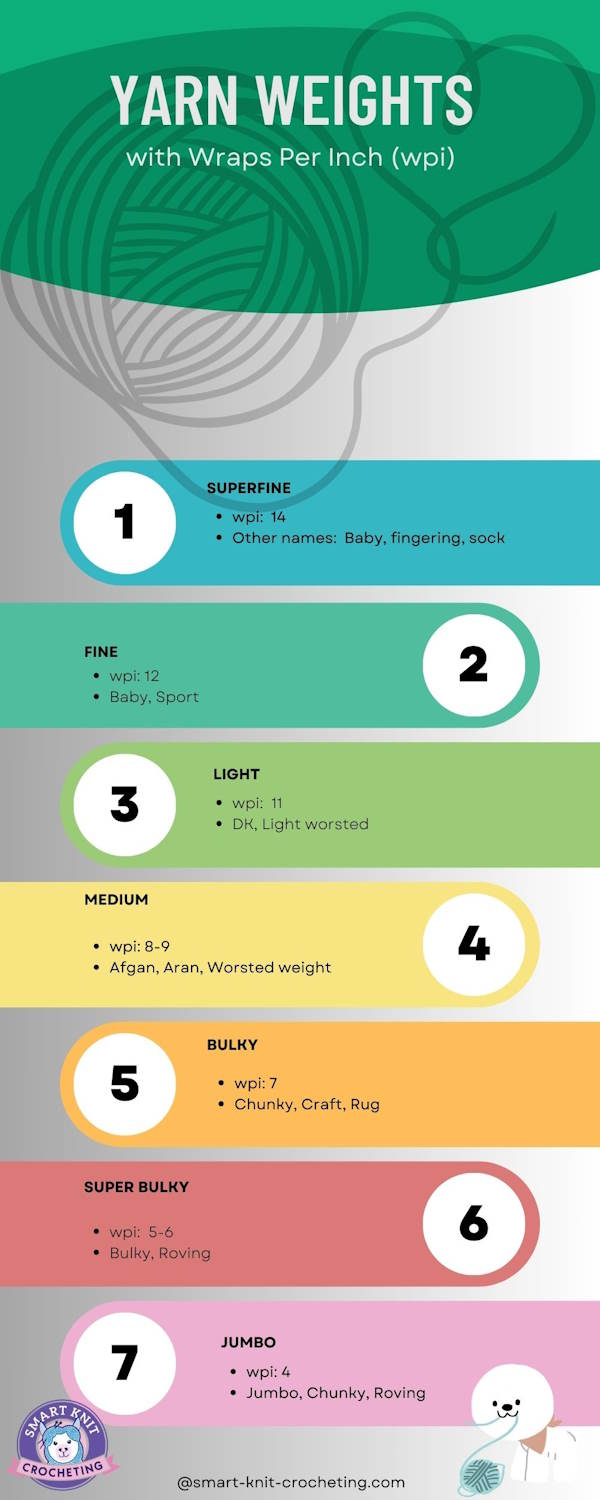 This Chart shows the names and numbers of the various yarn weights according to the craft yarn council.
This Chart shows the names and numbers of the various yarn weights according to the craft yarn council.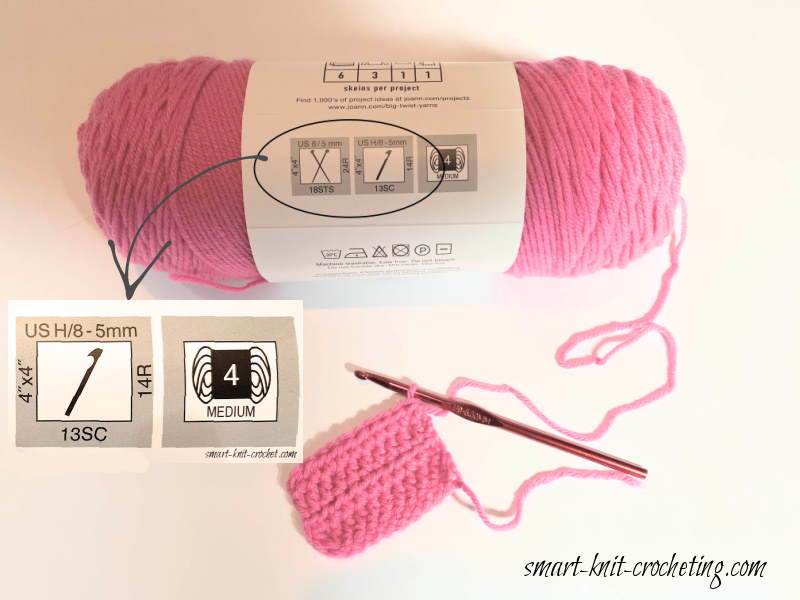 Understanding the symbols on a yarn label
Understanding the symbols on a yarn labelA Quick Explanation of "Gauge"
Scrutinize the pattern or the hank of yarn you are planning to use. You should find the gauge instructions that might look something like this:
This label tells you that the yarn is best used with a number H/8 (U.S.) or 5 mm (Metric) crochet hook. If you crochet a 4 x 4-inch square using single crochet (sc), you should end up with 14 rows and 13 sc stitches per row.
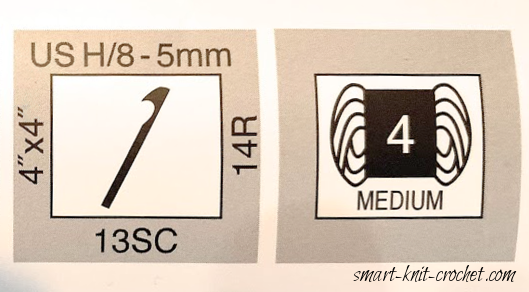
If you crochet a four-by-four-inch square and it doesn't appear that you have the correct gauge, you may need to use a crochet hook one size larger or smaller to meet gauge.
For this reason, I recommend purchasing a set of crochet hooks to be ready for any project.
Understanding gauge in crochet projects
How to Hold the Hook
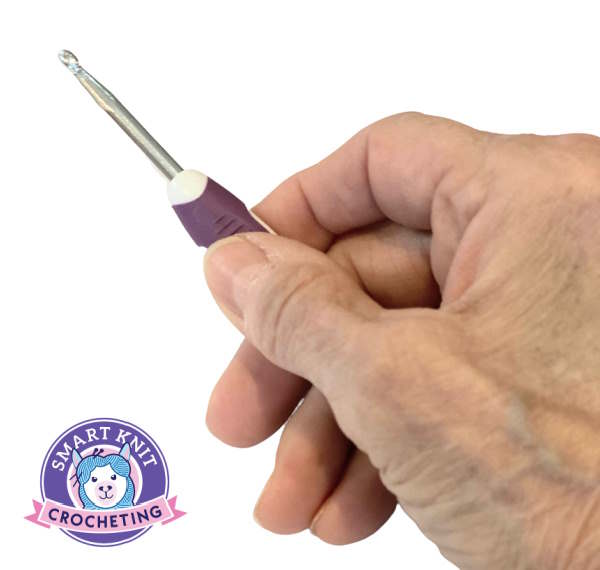 Crochet hook held as if it were a knife
Crochet hook held as if it were a knifeSome people hold the hook in the dominant hand as if they were holding a pencil. Another way to control the crochet hook is to grab it as if it were a knife.
You can try it both ways to see what feels best to you, but I find it more comfortable and less straining to hold it like a knife.
Experiment with both methods using a short piece of yarn to see what feels best for your hands.
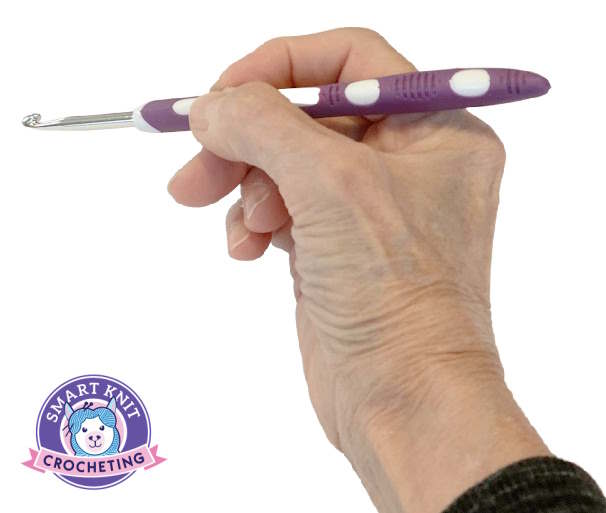 Crochet Hook held as if it were a pencil.
Crochet Hook held as if it were a pencil.Beyond Crochet Hooks
The Crochet hook is the essential tool in your crochet toolbox for creating that next outstanding project.
Still, without the other supplies, you won't get very far. Here are a few more critical tools to consider purchasing before your next project.
Vintage projects such as laces and doilies will call for cotton or other types of fibers. These are still manufactured and available both online and in large retail craft stores.
Yarn
You won't get very far with your crocheting without some form of fiber. Unless you are making very fine lace, you will want to learn a bit more about the various types of yarns available today, and options are abundant.
Other Necessary Crocheting Supplies
- Scissors or yarn cutters
- Tape measure
- Stitch markers
- Row counters
- Bobbins
- Yarn Needle
- Pencil, pen and notebook or calculator
- A case for your hooks
- Needle gauge
Learn more about crochet tools and accessories
